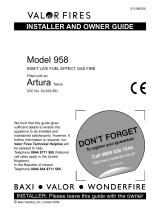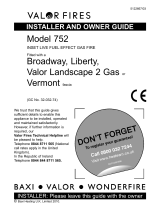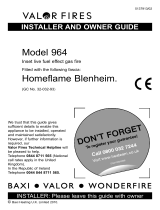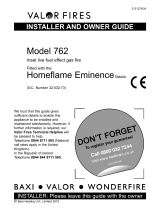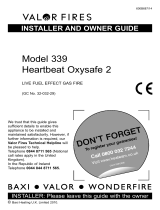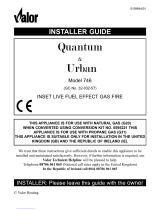Page is loading ...

5131883/01
© Baxi Heating U.K. Limited 2008.
Model 958
INSET LIVE FUEL EFFECT GAS FIRE
Fitted with an
Artura fascia
(GC No. 32-032-89)
We trust that this guide gives
sufficient details to enable this
appliance to be installed and
maintained satisfactorily. However, if
further information is required, our
Valor Fires Technical Helpline will
be pleased to help.
Telephone 0844 8711 565 (National
call rates apply in the United
Kingdom).
In the Republic of Ireland
Telephone 0044 844 8711 565.
INSTALLER: Please leave this guide with the owner
INSTALLER AND OWNER GUIDE

© Baxi Heating U.K. Limited 2008.
All rights reserved. No part of this publication may be reproduced in any material form
(including photocopying), stored in any medium by electronic means (including in any
retrieval system or database) or transmitted, in any form or by any means, whether
electronic, mechanical, recording or otherwise, without the prior written permission of
the copyright owner.
Applications for the copyright owner's permission to reproduce any part of this
publication should be made, giving details of the proposed use, to the following
address: The Company Secretary, Baxi Heating UK Limited, The Wyvern Business
Park, Stanier Way, Derby, DE21 6BF.
Warning: Any person who does any unauthorised act in relation to a copyright work
may be liable to criminal prosecution and civil claims for damages.
Valor Fires, Erdington, Birmingham B24 9QP
www.firesandstoves.co.uk
Because our policy is one of constant development and improvement, details may vary slightly from
those given in this publication
Page 2
© Baxi Heating U.K. Limited 2008.
THIS APPLIANCE IS FOR USE WITH NATURAL GAS (G20).
UNDER NO CIRCUMSTANCES IS THIS FIRE TO BE CONVERTED TO LPG.
AN LPG KIT DOES NOT EXIST FOR THIS GAS FIRE.
THIS APPLIANCE IS SUITABLE ONLY FOR INSTALLATION IN THE UNITED
KINGDOM (GB) AND THE REPUBLIC OF IRELAND (IE).

Safety First.
Valor Fires fires are CE Approved and designed to meet the appropriate British
Standards and Safety Marks.
Quality and Excellence.
All Valor Fires fires are manufactured to the highest standards of quality and
excellence and are manufactured under a BS EN ISO 9001 quality system accepted
by the British Standards Institute.
The Highest Standards
Valor Fires is a member of SBGI and HHIC (Heating and Hot water Industry Council)
that work to ensure high standards of safety, quality and performance.
Careful Installation
Valor Fires is a CORGI registered company. All our gas fires must be
installed by a competent CORGI Registered Installer in accordance
with our Installer Guide and should not be fitted directly on to a
carpet or floor of combustible material.
Page 3
© Baxi Heating U.K. Limited 2008.

Page 4
© Baxi Heating U.K. Limited 2008.
INSTALLER GUIDE
FOR OWNER GUIDE SEE PAGES 34 TO 47
INSTALLER GUIDE

CONTENTS
Section Heading Page
INSTALLER GUIDE 4 - 33
OWNER GUIDE 34 - 47
1. SAFETY 6
2. ACCESSORY LIST 6
3. APPLIANCE DATA 7
4. GENERAL INSTALLATION REQUIREMENTS 8
5. PACK CONTENTS 15
6. FIREPLACE CHECK 17
7. IGNITION CHECK 18
8. GAS SUPPLY CONNECTION 18
9. PREPARING APPLIANCE FOR INSTALLATION 19
10. HOTBOX INSTALLATION 22
11. BURNER & SUPPLY PIPE INSTALLATION 24
11.1 Fitting the burner. 24
11.2 Supply pipe installation. 24
11.3 Preliminary burner checks. 24
11.4 Check inlet pressure. 25
12. FASCIA INSTALLATION 26
13. FITTING THE CERAMIC FUEL EFFECT 26
14. FULL OPERATING CHECKS 27
14.1 Check the control settings. 27
14.2 Check for spillage. 27
15. FINAL REVIEW 29
16. SERVICING & PARTS REPLACEMENT 30
16.1 To remove the fascia. 30
16.2 To remove the burner unit. 31
16.3 To remove the pilot unit. 31
16.4 To remove the gas valve. 31
16.5 To remove the piezo generator. 32
16.6 To grease the control tap. 32
16.7 To replace the burner. 32
16.8 To remove the main burner injector. 33
16.9 To remove the appliance from the fireplace. 33
Page 5
© Baxi Heating U.K. Limited 2008.
INSTALLER GUIDE

1. SAFETY
Installer
Before continuing any further with the installation of this appliance please read the
following guide to manual handling:
The lifting weight (kg) of this appliance is as below:
Heat engine
Casting Fascia Total
6.80 3.84 3.00 13.64
One person should be sufficient to lift the fire. If for any reason this weight is
considered too heavy then obtain assistance.
When lifting always keep your back straight. Bend your legs and not your back.
Avoid twisting at the waist. It is better to reposition your feet.
Avoid upper body/top heavy bending. Do not lean forward or sideways whilst
handling the fire.
Always grip with the palm of the hand. Do not use the tips of fingers for support.
Always keep the fire as close to the body as possible. This will minimise the
cantilever action.
Use gloves to provide additional grip.
Always use assistance if required.
2. ACCESSORY LIST
The following accessories are available: -
Description Part Number
Pre cast and clay flue block spacer kit 05654K1
Page 6
© Baxi Heating U.K. Limited 2008.
INSTALLER GUIDE

3. APPLIANCE DATA
Under no circumstances is this fire to be converted to LPG. An LPG conversion kit
does not exist for this gas fire.
The appliance information label is located on a plate at the base of the fire. This can
be seen by lifting the bottom front cover of the fascia - See figure 5 on the last page
of the owner guide.
This product uses fuel effect pieces containing Refractory Ceramic Fibres
(RCF), which are man-made vitreous silicate fibres. Excessive exposure to
these materials may cause irritation to eyes, skin and respiratory tract.
Consequently, it is important to take care when handling these articles to
ensure that the release of dust is kept to a minimum. To ensure that the release
of fibres from these RCF articles is kept to a minimum, during installation and
servicing we recommend that you use a HEPA filtered vacuum to remove any
dust and soot accumulated in and around the fire before and after working on
the fire. When replacing these articles we recommend that the replaced items
are not broken up, but are sealed within a heavy duty polythene bag, clearly
labelled as RCF waste. RCF waste is classed as a stable, non-reactive
hazardous waste and may be disposed at a landfill licensed to accept such
waste. Protective clothing is not required when handling these articles, but we
recommend you follow the normal hygiene rules of not smoking, eating or
drinking in the work area and always wash your hands before eating or
drinking.
This appliance does not contain any component manufactured from asbestos or
asbestos related products.
Page 7
© Baxi Heating U.K. Limited 2008.
Gas Natural (G20)
Inlet Pressure 20mbar
Input Max. (Gross) 5.1kW (17,401 Btu/h)
Input Min. (Gross) 3.2kW (10,918 Btu/h)
Inlet Test Pressure (Cold) 20.0 ± 1.0mbar (8.0 ± 0.4in w.g.)
Gas Connection 8mm pipe
Burner Injector Cat. 82 Size 065
Pilot & Atmosphere Sensing Device Copreci Ref. O.D.S 21500/166
Ignition Integral piezo (Mounted on gas valve)
Aeration Non-adjustable
INSTALLER GUIDE

The efficiency of this appliance has been measured as specified in BS 7977 - 1 and
the result is as below :
Model
Efficiency % (Gross)
958 Artura 51
The gross calorific value of the fuel has been used for this efficiency calculation. The
test data from which it has been calculated has been certified by Advantica
Certification services (0087). The efficiency value may be used in the UK
Government's Standard Assessment Procedure (SAP) for energy rating of dwellings.
The convertion of net efficiency to gross was achieved by multiplying the net
efficiency by the following conversion factor from Table E3 of SAP 2005, rounding
down to the nearest whole number.
4. GENERAL INSTALLATION REQUIREMENTS
4.1 The installation must be in accordance with these instructions.
For the user’s protection, in the United Kingdom it is the law that all gas appliances
are installed by competent persons in accordance with the current edition of the Gas
Safety (Installation and Use) Regulations. Failure to install the appliance correctly
could lead to prosecution. CORGI requires its members to work to recognised
standards.
In the United Kingdom the installation must also be in accordance with:
All the relevant parts of local regulations.
All relevant codes of practice.
The relevant parts of the current editions of the following British Standards:-
BS 715
BS EN 1856 Part 1
BS 1251
BS EN 1858 which replaces BS 1289 Part 1
BS EN 1806 which replaces BS 1289 Part 2
BS EN 1856 Part 1 which replaces BS 4543 Part 2
BS 5440 Part 1
BS 5440 Part 2
BS 5871 Part 2
BS 6461 Part 1
BS 6891
BS 8303
In England and Wales, the current edition of the Building Regulations issued by the
Department of the Environment and the Welsh Office
Page 8
© Baxi Heating U.K. Limited 2008.
Gas Conversion factor from net to gross efficiency
Natural Gas 0.901
INSTALLER GUIDE

In Scotland, the current edition of the Building Standards (Scotland) Regulations
issued by the Scottish Executive.
In Northern Ireland, the current edition of the Building regulations (Northern Ireland)
issued by the Department of
the Environment for Northern Ireland.
In the republic of Ireland the installation must also conform to the relevant parts of:
a) The current edition of IS 813 “Domestic gas installations”
b) All relevant national and local rules in force.
Where no specific instructions are given, reference should be made to the relevant
British Standard Code of Practice.
4.2 In the United Kingdom, as supplied, the appliance can be installed in the
following
situations: -
4.2.1 To a fireplace complete with surround and hearth as shown in figure 1 and
complying with BS1251 after removal of the fireback and sufficient material behind the
fireback for a debris catchment space. The required fireplace, hearth, debris
catchment area and clearance dimensions are shown in figure 1.
4.2.2 ‘Hole-in-the-wall’ installations.
It is recommended that a
hearth should be installed
as in figure 1.
If a hearth is not fitted, the
fire must be installed so
that the distance from the
base of the fireplace
opening in the wall to the
finished floor level is at
least 85mm.Where there
is no floor covering or
carpet and the floor is of a
type that is likely to be
covered in such a way
then the distance from the
base of the fireplace
opening in the wall to the
finished floor level should
be increased to at least
160mm. The minimum
shelf height will have to be taken from the base of the fireplace opening.
To protect from the risk of burns and ignition of clothing a tactile separator shall be
used. The hearth detailed in section 4.9 meets the requirements for a tactile
separator. If this is not used then a 672mm long fender, kerb, horizontal bar, or other
barrier, being fixed not less than 50mm above floor level and positioned 300mm in
Page 9
© Baxi Heating U.K. Limited 2008.
Figure 1. Hearth and fireplace opening dimensions
INSTALLER GUIDE

front of the fixing plane of the fire will
meet the requirement.
4.2.3 To a fireplace incorporating a
metal flue box complying with the
constructional requirements of the
current edition of BS715. The
dimensions of the flue box must
conform to those shown in figure 2.
4.2.4 A precast concrete or clay flue
block system conforming to BS1289
or BS EN 1806 with dimensions as
in figure 3 or using a 05654K1
spacer kit. (Installation Instructions
part number 3003095). The current
versions of BS1289 and BS EN
1806 recommend that there should
be an air space or insulation
between the flue blocks and the
plaster because heat transfer may
cause cracking on directly
plastered flues. However, generally
this appliance is suitable for
installations under all
circumstances unless there is a
history of cracking problems.
Remember that faults such as
cracking may be caused by poorly
built and restrictive flues, e.g.
mortar extrusions, too many bends,
flue heights below three metres,
restrictive terminations etc (See
figure 3).
4.2.5 If the fireplace opening is
greater than the acceptable
dimensions given in this guide, do
not use the back of a fire surround
or marble to reduce the opening.
This may cause cracking of the
surround back or marble.
Page 10
© Baxi Heating U.K. Limited 2008.
Figure 3. Precast or clay flue block system
dimensions
Figure 2. Metal flue box
INSTALLER GUIDE

4.3 Suitable flues and minimum flue sizes are as follows: -
It should be noted that, as with many appliances, sharp bends or horizontal runs in
metal flues at the top of the system can be a cause of problems in these types of
installation.
225mm x 225mm conventional brick flue.
175mm diameter lined brick or stone flue.
200mm diameter factory made insulated flue manufactured to BS4543.
175mm diameter flue pipe. See BS6461 Part 1 for suitable materials.
Single wall, twin wall or flexible flue liner with a minimum diameter of 125mm. The
materials to be used are stainless steel or aluminium as specified in BS715. The liner
must be sealed to the surrounding area above the fireplace opening and to the top of
the chimney. An approved terminal must be fitted.
A properly constructed precast concrete or clay flue system conforming to BS1289
or BS EN 1806. This system is only suitable if the conditions stated in section 4.2.4
are met.
4.4 The flue must conform to BS 5440: Part 1 in design and installation.
The flue, measured from the bottom of the fireplace opening to the bottom of the
terminal, shall be not less than 3m in actual vertical height. When calculated in
accordance with BS 5440: Part 1 Annex A, the minimum equivalent height of the flue
shall be 2.0m of 125mm-dia. flue pipe.
4.5 The flue must not be used for any other appliance or application.
4.6 Any chimney damper or restrictor should be removed. If removal is not possible,
they must be secured in the open position.
4.7 If the appliance is intended to be installed to a chimney that was previously
used for solid fuel, the flue must be swept clean prior to installation. All flues should
be inspected for soundness and freedom from blockages.
4.8 If the fireplace opening is an underfloor draught type, it must be sealed to stop
any draughts.
4.9 The appliance must be mounted behind a non-combustible hearth (N.B.
conglomerate marble hearths are considered as non-combustible). The appliance can
be fitted to a purpose made proprietary class “O”-150°C surround. The hearth
material must be at least 12mm thick. The periphery of the hearth (or fender) should
be at least 50mm above floor level to discourage the placing of carpets or rugs over
it.
The surface of the hearth must be sufficiently flat to enable the bottom of the fascia
and the bottom front cover to be aligned horizontally. Any excessive unevenness
(uneven tiles, Cotswold stone, etc.) should be rectified.
The appliance must not stand on combustible materials or carpets.
Page 11
© Baxi Heating U.K. Limited 2008.
INSTALLER GUIDE

4.10 The front face of the fireplace should be reasonably flat over the area covered
by the hotbox top and side flange seals to ensure good sealing. These faces should
be made good if necessary.
The fireplace floor should be reasonably flat to ensure that a good seal with the
hotbox can be made.
4.11 Note that soft wall coverings (e.g. embossed vinyl, etc.) are easily affected by
heat. They may scorch or become discoloured when close to a heating appliance.
Please bear this in mind when installing.
4.12 This appliance must not be installed in any room that contains a bath or shower
or where steam is regularly present.
4.13 An extractor fan may only be used in the same room as this appliance, or in any
area from which ventilation for the appliance is taken, if it does not affect the safe
performance of the appliance. Note the spillage test requirements detailed further on
in this manual. If the fan is likely to affect the appliance, the appliance must not be
installed unless the fan is permanently disconnected.
4.14 Normal adventitious ventilation is usually sufficient to satisfy the ventilation
requirements of this appliance. In GB reference should be made to BS 5871 Part 2
and in IE reference should be made to the current edition of IS 813 “Domestic Gas
Installations” which makes clear the conditions that must be met to demonstrate that
sufficient ventilation is available.
4.15 If the appliance is to be fitted against a
wall with combustible cladding, the cladding
must be removed from the area covered by
the fascia. The cladding must also not touch
the fascia (See figure 4). We suggest that the
actual fascia is used as a template to mark the
area for combustible cladding removal and
that this area is increased by at least 2mm all
round. If the cladding projects forward from the
fixing plane of the fire the clearance at the top
of the appliance must be increased to a
minimum 15mm.This will allow for fascia
removal.
4.16 A fireguard complying with BS 8423
should be fitted for the protection of young
children, the elderly, or the infirm.
Page 12
© Baxi Heating U.K. Limited 2008.
Figure 4. Removal of
combustible cladding
INSTALLER GUIDE

4.17 The minimum height from the base of the fireplace opening to the underside of
any shelf made from wood or other combustible materials is shown below:-
• For a shelf up to 150mm deep
Minimum height = 750mm.
• For a shelf deeper than 150mm
Minimum height = 750mm + 12.5mm for every 25mm depth over 150mm.
(See graph 1).
4.18 Proprietary terminals must comply with BS 715 or BS 1289. Any terminal or
termination must be positioned in accordance with BS 5440 Part 1 to ensure that the
products of combustion can be safely dispersed into the outside atmosphere. Where
the appliance is connected to an unlined brick chimney it is generally unnecessary for
the chimney pot to be replaced or for a terminal to be fitted unless the flue has a
diameter smaller than 170mm.
4.19 The appliance is fitted with an A.S.D (Atmosphere sensing device). If the
appliance closes down after a period of operation for no apparent reason, the
consumer should be informed to stop using the appliance until the installation and
appliance have been thoroughly checked. The A.S.D will shut the appliance down if
an unacceptable amount of harmful products of combustion accumulate. Under no
circumstances should the A.S.D be altered or bypassed in any way. Only a genuine
manufacturers replacement part should be fitted. The individual A.S.D components
are not replaceable.
4.20 The minimum allowable distance from the outside of the appliance fascia to a
corner wall having combustible material or any other combustible surface which
projects beyond the front of the appliance is shown in figure 5.
Page 13
© Baxi Heating U.K. Limited 2008.
Graph 1. Combustible shelf clearances
INSTALLER GUIDE

Page 14
© Baxi Heating U.K. Limited 2008.
Figure 5. Appliance dimensions and clearances (Fascia may differ from that shown)
Key Description
Dimension
(mm)
A Appliance height 702
B Appliance width 594
C Appliance depth into room 100
D
Minimum mandatory clearance to combustible
surfaces projecting beyond the front of appliance.
10
E
Recommended clearance to non-combustible
surfaces for access purposes.
10
INSTALLER GUIDE

5. PACK CONTENTS
(See figure 6).
Carefully remove all the contents. Take special care in handling the ceramic fuel
effects. Check that all the listed parts are present and in good condition. The pack
may contain additional components to that stated above. These can be discarded.
1 Burner & Hotbox Unit
1 Spillage plate.
1 Nut & olive for 8mm inlet pipe
1 Inlet ‘T’ Connector
1 Flue restrictor plate
2 Screws (For flue restrictor)
2 Fireback spacing brackets
2 Screws (For Fireback spacing brackets)
1 Ceramic fuel effect pack (Not shown)
1 Strip of floor sealing tape.
6 Fibre / wooden plugs
2 Woodscrews
2 Fire retaining cables
2 Cable clamps
4 Eyebolts
1 Rubber grommet
1 Smoke match tube
1 Length of self adhesive foam seal
1 Literature pack
1 Fascia
1 Fascia casting
1 Spacer frame (This is supplied as three separate pieces and 2 screws)
6 Edge clips (For securing spacer frame to hotbox).
Page 15
© Baxi Heating U.K. Limited 2008.
INSTALLER GUIDE

Page 16
© Baxi Heating U.K. Limited 2008.
Figure 6. Pack contents
INSTALLER GUIDE

6. FIREPLACE CHECK
6.1 Fireplace check.
6.1.1 Fireplace size
The fireplace must comply with
the requirements described in
section 4.2. This will probably
entail removing the fireback and
infill material behind the
fireback. The debris catchment
area shown in figure 7 must be
kept clear of obstructions.
6.1.2 Fireplace general
condition
The fireplace floor should be
reasonably flat to ensure that
the hotbox can be installed
without it rocking and so that a
good seal can be made at the bottom front of the box. The front face of the fireplace
should be reasonably flat over the area covered by the hotbox top and side flange
seals to ensure good sealing. These faces should be made good if necessary. If the
appliance is to be fitted against a wall with combustible cladding, the cladding must
be removed from the area covered by the fascia. The cladding must also not touch
the fascia (See figure 4). We suggest that the actual fascia is used as a template to
mark the area for combustible cladding removal and that this area is increased by at
least 2mm all round.
6.1.3 Soundness for appliance attachment
A primary method of retaining the appliance is provided. This involves using
concealed tension cables fixed to the rear of the fireplace opening together with
secondary fixing to the fireplace floor. This method is detailed in section 10 of this
manual. This method is particularly useful for instances where drilling holes in the
front surface of the fireplace surround is unacceptable to the customer or otherwise
impractical. N.B. It is unwise to attempt to drill into marble without the proper tools
and equipment.
Make sure that the areas at the back and towards the centre of the fireplace floor are
sound enough to take the eyebolts and screws. If these areas have deteriorated due
to prolonged use, they should be made sound with suitable cement.
6.1.4 Installations using a metal flue box
The whole of the top surface of the metal flue box must be covered with a 100mm
layer of mineral wool or equivalent insulation (See figure 2).
Page 17
© Baxi Heating U.K. Limited 2008.
Figure 7. Fireplace area
INSTALLER GUIDE

6.2 Fireplace flue pull.
Close all doors and windows in the room in which the appliance is to be installed.
After confirming with a match that smoke is drawn into the flue, light a 13 gram
smoke pellet and check that there is a definite flow through the flue. Verify outside
that the smoke exits from one terminal only and that the termination is suitable.
Observe where possible, upstairs rooms and loft spaces for signs of escaping smoke
indicating a defective flue. If there is not a definite flow warm the flue for a few
minutes and repeat the smoke pellet test. If there is still no definite flow the flue may
need remedial work – Do not fit the appliance until there is a definite flow
through the flue.
7. IGNITION CHECK
Before attempting to install, it is worth checking that the ignition system performs
satisfactorily.
Set the control knob to the off position.
Depress the control knob and rotate it anticlockwise to the pilot ignition position. A
'click' will be heard as the integral
piezo operates. A spark should be
seen between the electrode and
pilot tip. If there is no spark check
the following: -
Ensure that the electrode lead
is connected to the terminal at the
base of the electrode.
If the above is correct, check
for damage to the electrode lead.
8. GAS SUPPLY CONNECTION
A nut and olive are provided for an 8mm pipe inlet connection to the ‘T’ connector at
the bottom front of the appliance. The ‘T’ connector can be rotated to allow a
connection from any direction. The ‘T’ connector includes a valve for isolating the gas
supply and a pressure test point.
The supply pipe must be rigid material. Flexible pipe must not be used.
Concealed supply pipe connection.
If a concealed connection from inside the fireplace is required then, before the
appliance is fitted into the fireplace it will be necessary to extend the supply line so
that it will project through the hole in the back of the hotbox and run to the ‘T’
connector at the front. The pipe run from the supply line up to the rear opening in the
hotbox must be kept away from the area which will be taken by the hotbox when it is
installed. Note that the centre of the appliance inlet ‘T’ connector is 25mm above the
fireplace floor. The inlet ‘T’ connector should be fitted to the supply pipe at this stage.
Page 18
© Baxi Heating U.K. Limited 2008.
Figure 8. Ignition operation
INSTALLER GUIDE

9. PREPARING APPLIANCE FOR INSTALLATION
1. Remove the two screws to the side of the burner unit.
2. Detach the burner unit from the hotbox by lifting clear.
3. It is important that the grommet supplied in the loose parts pack is fitted to
the hole in the rear of the hotbox.
4. For concealed connection only
: Pierce the grommet to allow the pipe to pass
through it. The grommet should envelop the pipe. If the hole is larger than the pipe,
seal it with tape. Do not pierce the grommet unless
the supply pipe is to pass through it.
5. The appliance is supplied with two fireback spacers.
Do not fit the fireback spacers if the fire is to be
installed into a precast or clay flue block system as
in section 4.2.4. These should extend backwards to
ensure sufficient clearance from the back of the fireplace.
Remove the label and retaining screws from the rear
sides of the hotbox. Position the fireback spacers as
shown in figure 9. Secure the fireback spacers using the
screws removed previously, and the two supplied with
the fire.
6. This appliance is supplied with a flue restrictor for use
where the flue draught is excessive. Generally we
recommend the restrictor is NOT fitted where a precast
flue, metal flue box or a flue liner is used,
however ,certain flues may work sufficiently
to warrant its use. There may however, be
circumstances where fitting the restrictor
causes the fire to fail the spillage test. In
such cases the restrictor will have to be
removed. After removal conduct the spillage
check again.
The restrictor is packed loose with the
appliance and is fixed with three screws
(See figure 10).
Page 19
© Baxi Heating U.K. Limited 2008.
Figure 10. Flue restrictor
Figure 9. Fireback spacers
INSTALLER GUIDE

7. Supplied with the fire are a short and long
length of self adhesive foam seal. Take the
short length, peal off the adhesive backing
and stick it to the underside of the hotbox
(See figure 11).
8. Supplied with the fire is a spacer frame.
This is made up of three separate pieces, a
top and two sides. The three pieces are
identified in figure 12.
9. The sides have a stepped top face. These
must be located on the inside the top piece
(See point 1 of figure 13). The tabs on the top
piece must locate on the inside of the side
pieces (See point 2 of figure 13). Secure the
two side pieces to the top piece using
two self tapping screws supplied.
Locate the screws from inside the ‘U’
channel.
Page 20
© Baxi Heating U.K. Limited 2008.
Figure 13. Spacer frame assembly
Figure 12. Assembling the spacer frame
Figure 11. Fitting the foam seal to
the base of the hotbox.
INSTALLER GUIDE
/
